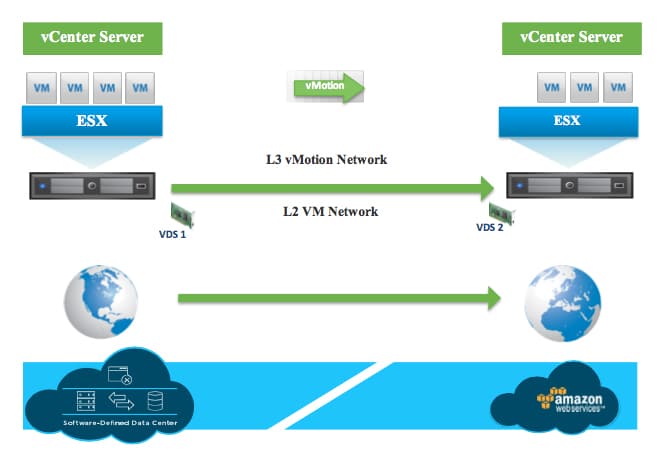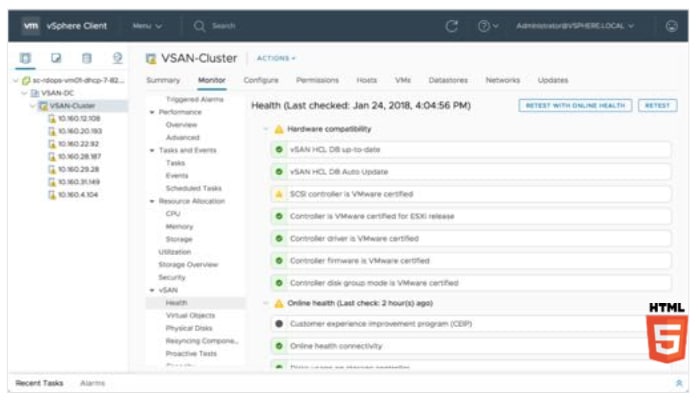Today VMware rolled out new updates to both VMware vSphere and VMware vSAN, bringing both up to version 6.7. vSphere and vSAN are the industry’s leading hyper-converged infrastructure (HCI) solutions. These new sets of updates are stated as enhancing user experience, security, application support, and hybrid cloud management features.
Today VMware rolled out new updates to both VMware vSphere and VMware vSAN, bringing both up to version 6.7. vSphere and vSAN are the industry’s leading hyper-converged infrastructure (HCI) solutions. These new sets of updates are stated as enhancing user experience, security, application support, and hybrid cloud management features.

As more and more companies are embracing their digital transformations they are running into increasingly complex technology environments. Not only that public cloud services and data center resources have rapidly grown and in many cases become necessary for enterprises to utilize. Noting this, VMware has updated its HCI solutions to provide its customers with a fully integrated digital foundation across the heterogeneous hybrid cloud.
The first part of the promise is VMware vSphere 6.7. The company states that its new capabilities and enhancements will help deliver an efficient and more secure platform for all hybrid cloud environments. 6.7 will feature simple and efficient management at scale, comprehensive built-in security, increased support for more workloads, and further enable a seamless hybrid cloud experience. The latest version of vSphere will also continue to be a universal application platform that supports workloads spanning AI, ML, Big Data, business-critical, cloud-native, in-memory, and 3D graphics, among others.
New and enhanced features in VMware vSphere 6.7 include:
- New vCenter Hybrid Linked Mode: Will enable unified visibility and management across different versions of vSphere running on-premises and in the public cloud such as VMware Cloud on AWS or IBM Cloud or other VMware Cloud Provider Program partners. This will allow customers to maintain their current version of vSphere on-premises as needed while enjoying the benefits of new capabilities in vSphere-based public clouds.
- New ESXi Single Reboot and vSphere Quick Boot: Will significantly reduce patch and upgrade times by halving the number of reboots required to one, while vSphere Quick Boot will skip hardware initialization steps to gain further re-start efficiencies.
- New vSphere Persistent Memory: Will leverage the latest innovation around non-volatile memory and significantly enhance performance for both existing and new apps.
- Enhanced NVIDIA GRID vGPUs Support for Modern Workloads: Will improve host lifecycle management and reduce end-user disruption via new suspend and resume capabilities for VMs running on GPUs. vSphere 6.7 will enhance support for vGPU VMs for use of AI and ML workloads in addition to VDI workloads.
- New Trusted Platform Module (TPM) 2.0 Support and Virtual TPM 2.0: This combination will significantly enhance protection and integrity for both the hypervisor and the guest operating system (OS). Virtual TPM 2.0 will help prevent VMs and hosts from being tampered or compromised, preventing the loading of unauthorized components and enable guest OS security features.
- Enhanced VMware vSphere Client: This new release of the HTML-5-based vSphere client will introduce new functionality to manage VMware NSX, vSAN and vSphere Update Manager along with an increased support for third-party products.
VMware are introducing performance improvements and improved end user experiences through its enhanced vCenter Server Appliance. Compared to vSphere 6.5 the new version is 200% faster performance in vCenter operations per second, 300% reduction in memory usage, and 300% faster DRS-related operations (e.g. Power-on, Placement of VM).
VMware vSAN has quickly grown to be the leading HCI software providers and has spilled over into the large public cloud space in both AWS and IBM clouds. vSAN allows its customers to efficiently mange their operations for a low TCO. The latest version aims to reduce time-to-expertise, adds a new interface, as well as advanced monitoring and analytics.
New and enhanced features in VMware vSAN 6.7 include:
- New VMware vSphere HTML5 Client Support: Will provide vSAN administrators with a unified, intuitive management experience using the HTML5-based vSphere Client that introduces new functionality and optimized workflows for vSAN operations.
- New Integrated vRealize Operations Healthchecks in vCenter Server: Will offer a single pane of glass to monitor and control multiple HCI environments. vRealize Operations 6.7 will provide global operations view of vSAN 6.7 environments with six new dashboards embedded within vCenter Server 6.7 allowing customers to monitor capacity, performance, KPIs and alerts, and more. This capability does not require a separate vRealize Operations license and is available to anyone with a vSAN Advanced or vSAN Enterprise license.
- New Host-Pinning and iSCSI failover support: Will extend the suitability of HCI to applications such as Cassandra, Hadoop and MongoDB as well as to clustered Windows Server environments. New application support requires customers to contact VMware for additional details.
- New Intelligent Self-Healing Capabilities: Will mitigate the effects of disruptive events such as hardware failures with smart resource allocation.
- Enhanced vSAN Encryption: Will meet strict U.S. Federal government security requirements with FIPS 140-2 validation to protect data from disruptive events.
VMware also announced vSAN ReadyCare to support its HCI environments. The new service helps customers avoid or quickly resolve issues that in turn maintains performance and availability. This is done through a combination of proactive telemetry capabilities from vSAN Support Insight advanced analytics, and a broad investment in VMware support staff.
Availability
VMware vSphere 6.7 and VMware vSAN 6.7 are both expected to become available by May 2018.
Sign up for the StorageReview newsletter

